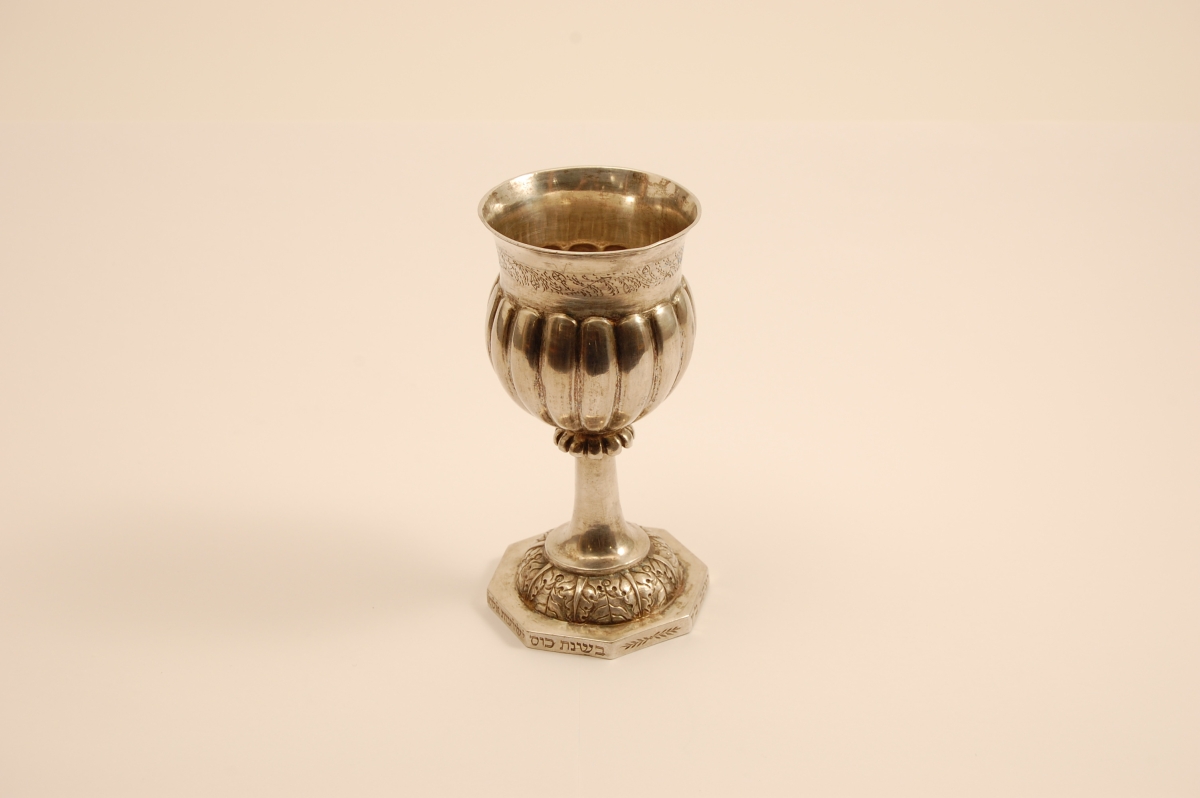"Not Ordinary but Never Strangers - Biržai Jews"
"Not Ordinary but Never Strangers - Biržai Jews"
The first Jews arrived to settle in Biržai Duchy at the end of the 16th century. The duke Christopher Radziwiłł The Thunderbolt, who promised them protection from their neighbours, invited them. There are documents from the 1600’s which mention Jews settling in Biržai and receiving the rights of settlement.
Jews made a living trading in flax and wood. There were weaving and knitting factories, flour mills, furniture manufacturers, tanneries, a winery, dairy industry, a pottery factory, an electric station and several other small industries as well as a Jewish bank.
The daily activities of the Jews of Biržai were filled with normality, social awareness and religious devotion. There were rabbis, synagogues, houses of Torah study, a kindergarten, a Tarbut – a secular Hebrew primary and high school. There were charitable organizations, a home for the elderly, an orphanage, a health clinic, Jewish sports clubs and a number of Zionist organizations. There were two musical groups which were famous throughout Lithuania. A Jewish photographer immortalized images of Biržai.
One month after the Germans entered Biržai, Jews were evicted from their homes and forced into a ghetto. A Jewish doctor, renowned for his care of all citizens, rich and poor, was the first of the fifteen victims who were shot by German soldiers and buried in the Biržai Jewish cemetery.
On 8 August 1941, 2,400 Jews: 900 children, 780 women and 720 men were brought to Pakamponys forest and brutally murdered; shot by Gestapo officers and about 80 Lithuanian collaborators. The citizens of Biržai - ordinary people, men, women and children - were killed because they were Jews.
Hundreds of names of victims of the mass murder are not known but we mourn their loss.
RELIGIOUS LIFE
The first synagogue in Biržai was mentioned in the ’30s–’40s of the 17th century.
The beit midrash was mentioned in 1863 and in 1879.
The existence of a Hasidic (probably Habad) community is mentioned in 1873, thus implying the existence of a separate Hasidic synagogue.
In the interwar period(1918–1940), there was a masonry Great Synagogue, two wooden batei midrash, one of which was called the Great Beit Midrash, two wooden kloyzn, the one of shoemakers' named Poalei Tsedek and the other of shamashim, and the wooden shtibl of the Habad Hasidim. The latter was rebuilt into a magnificent brick synagogue in 1938.

The shoemakers' kloyz. Photo by B. Michelsonas, the ’20s–’30s of the 20th century. Yad Vashem, 197EO8

The kloyz of shamashim. Photo by B. Michelsonas, the ’20s–’30s of the 20th century. Yad Vashem, 197FO1
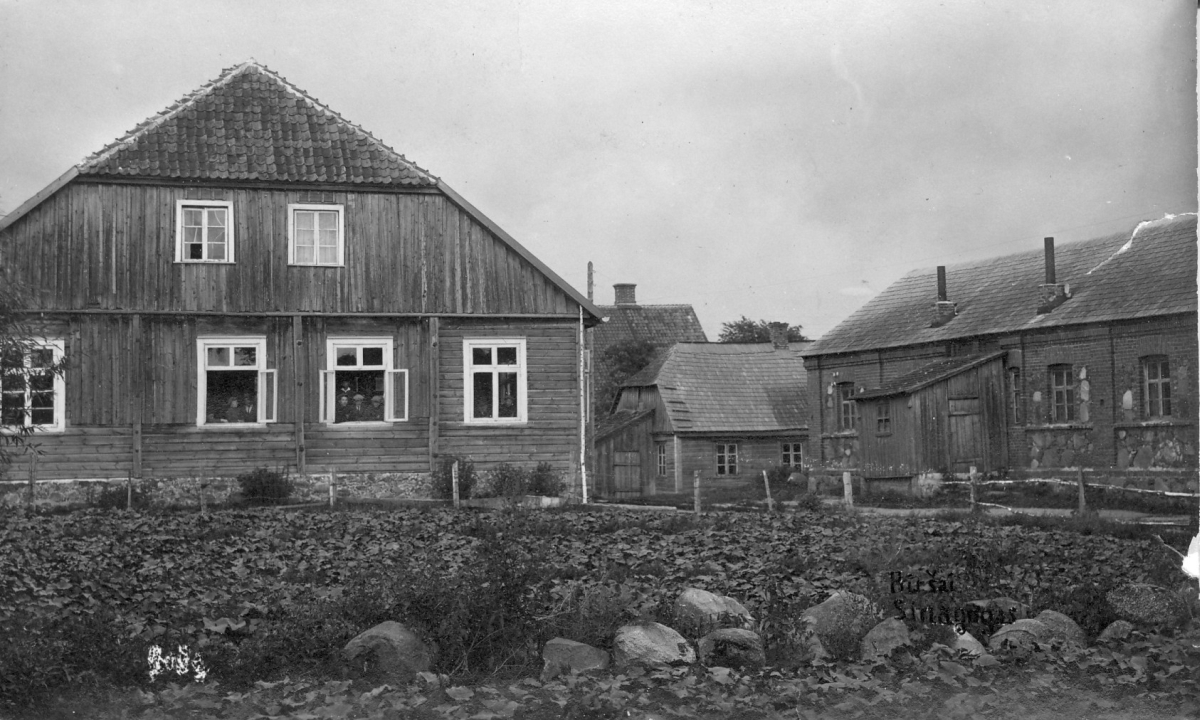
The Great Beit Midrash and the Great Synagogue on Karaimų Str. Photo by P. Ločeris, 1926, BRM „Sėla“

The Great Beit Midrash on Karaimų Str. Photo by B. Michelsonas, the ’20s–’30s of the 20th century. Yad Vashem, 197FO2

The Synagogue on Karaimų Str. (on the right side). View from the river Apaščia, 1938–1941, A. Miškinis' archives.

The Great Synagogue, the view from the southwest. Photo by B. Michelsonas, the ’20s–’30s of the 20th century. Yad Vashem, 197EO9.

The Synagogue of Habad Hasidim, the ’20s–’30s of the 20th century. Yad Vashem, 197EO7
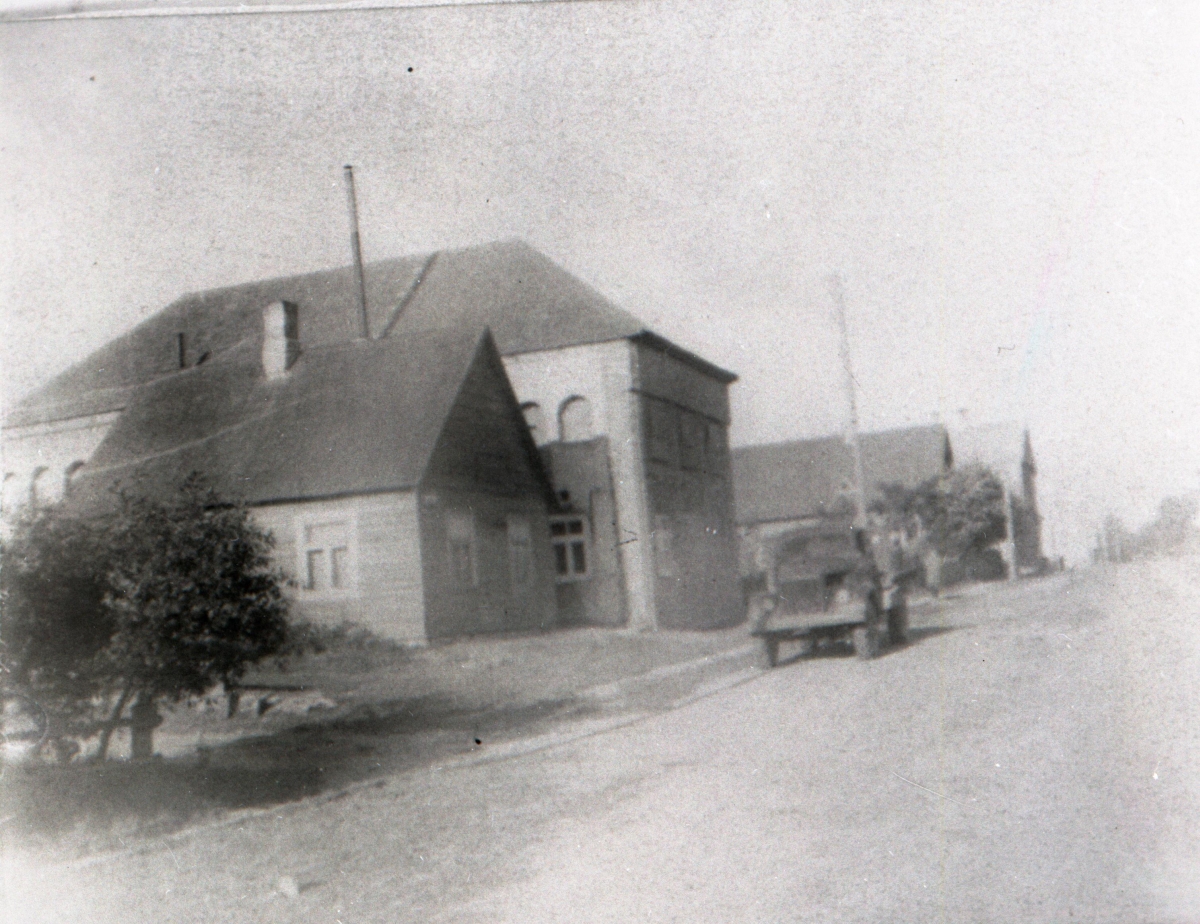
The new Synagogue of Habad Hasidim on S. Dagilio Str. Built in 1938. The architect – M. Lurje
The goblet for drinking wine on Shabbat day with the inscription in Hebrew: „DAVID SON OF OUR TEACHER RABBI JACOB KATZ / IN THE YEAR 1840 /I WILL LIFT UP THE CUP OF SALVATION“. The last sentence is taken from the psalm 116, the column 13.
In the early 20th century, Jewish children were able to receive a comprehensive education in Biržai.
There were some schools: Tarbut (secular, taught in the Hebrew language), Jewish Cultural League (secular, taught in the Yiddish language), Yavne (Orthodox, taught in the Hebrew language), several cheders (private religious primary schools), and a Jewish kindergarten.
Jewish children also studied at Biržai Gymnasium (founded in 1917) and in the yeshiva (higher religious school for young boys and men) which was founded by the rabbis Leib Bernshtein and Benyamin Movsha in 1930.

Biržai schoolchildren and pupils from Jewish primary school are planting the „Vilnius tree“ by the ruins of Radziwiłł castle. 1924 05 01. BRM „Sėla“ 18144/4.

Schoolchildren and teachers of Biržai four-grade school. 1915. In the first row from the left: S. Šalučkaitė, F. Etingaitė, A. Slavinskaitė, S. Paliulytė, M. Rūtaitė, A. Kaupelytė, O. Vaitaitytė, A. Skuja, R. Bermanaitė. In the second row are the teachers: J. Stiebris, P. Droževas, V. Miškovskaja, F. Zditoveckis, Orthodox priest N. Ivacevičius, Catholic priest K. Rimkevičius, priest of the Reformed church P. Jakubėnas, schoolboy J. Jakubonis. In the third row: P. Januševičius, J. Variakojis, teacher Limanovskis, J. Januševičius, I. Gendleris, H. Jansonas, P. Janonis. In the fourth row: M. Jofė, L. Valiulis, J. Gaidelionis, O. Rozenbergas, P. Krištofovičius, Peikštenis. In the upper row: P. Šernas, A. Kudukis, M. Striužas, A. Likerauskas, J. Atstupėnas, J. Janilionis. BRM „Sėla“ 19721/2.
The house of the industrialist Jansonas on Vytauto street. Biržai gymnasium was on the ground and the second floors of the house from 1917 till 1931. In 1908–1915 there was a four-grade Biržai school. Photo by P. Ločeris. BRM „Sėla“ 4753.

S. Kacas’s house on Vytauto street (so-called vištinyčia (i.e. a rooster)). In the centre there was an entrance to the first floor which was rented by Biržai gymnasium. BRM „Sėla“ 20860/376.

Biržai gymnasium was built in 1931. The author of the project was the architect V. Landsbergis-Žemkalnis. Photo by P. Ločeris. BRM „Sėla“ 20860/387.

The fifth grade students of Biržai gymnasium with the French language teacher Aimee Madrolle. 1922. From the left: Janis Berzinis, Rachilė Kacaitė, Aukštikalnytė?, Regina Karnauskaitė-Nastopkienė, teacher Aimee Madrolle, Paulina Vasiliauskaitė, Janina Žurauskaitė, Eugenija Snarskytė. Stands: Kostas Snarskis, Petras Lapienė, Jonas Dagys, Petras Balčiūnas, Jurgis Balčiūnas, Antanas Sprindys, Jonas Dagys. BRM „Sėla“ 18503/1.

The first graduates from Biržai gymnasium. 1923. In the first row from the left: Jonas Lapėnas, Adelė Vaitaitytė, class teacher Jonas Dilys, Leonarda Mačiukaitė, Dovydas Chenkinas. In the second row: Vladas Klusis, Juozas Sprindys, Kazys Kairys, Marcelė Balčiūnaitė, Vladas Jakubėnas, Cilė Šeinkeraitė, Dovydas Kacas, Jonas Mizaras. Photo by P.Ločeris. BRM „Sėla“ 22188.

Students of Biržai gymnasium. 1923. In the first row from the left sits: x, Estera Lurjytė, x, Makarauskas. In the second row: Lurjytė (died in Vilnius ghetto), x, x, V. Šlekys, x, I. Trečiokaitė-Žebenkienė, Sulamita Evinaitė (pharmacist, died in Plateliai). Stands: Sietnikas, Leonas Šušys, Astrauskas, x, x, Rinelis, x, x, x, Vytautas Niurka, Bilevičius. BRM „Sėla“ 21322/1.

The Teachers’ Council of Biržai gymnasium and the representatives of the Parents’ Committee in 1930–1931. Sits from the left: A. Levinas, E. Šlekienė, M. Bernšteinaitė, headmaster A. Juška, J. Kutra, N. Karosaitė, J. Bružas. In the second row: V. Januškevičius, A. Šernas, O. Mikelėnienė, K. Linkevičius, J. Survilienė, A. Jurgutis, E. Nastopkienė, P. Andrėjauskas, priest P. Rauda. In the third row: J. Mindlinas, A. Karalius, A. Puodžiūnas, priest J. Nagulevičius, M. Ušerauskaitė, V. Didžiulis, R. Klasčius, E. Kačarauskaitė. Photo by P. Ločeris. BRM „Sėla“ 14056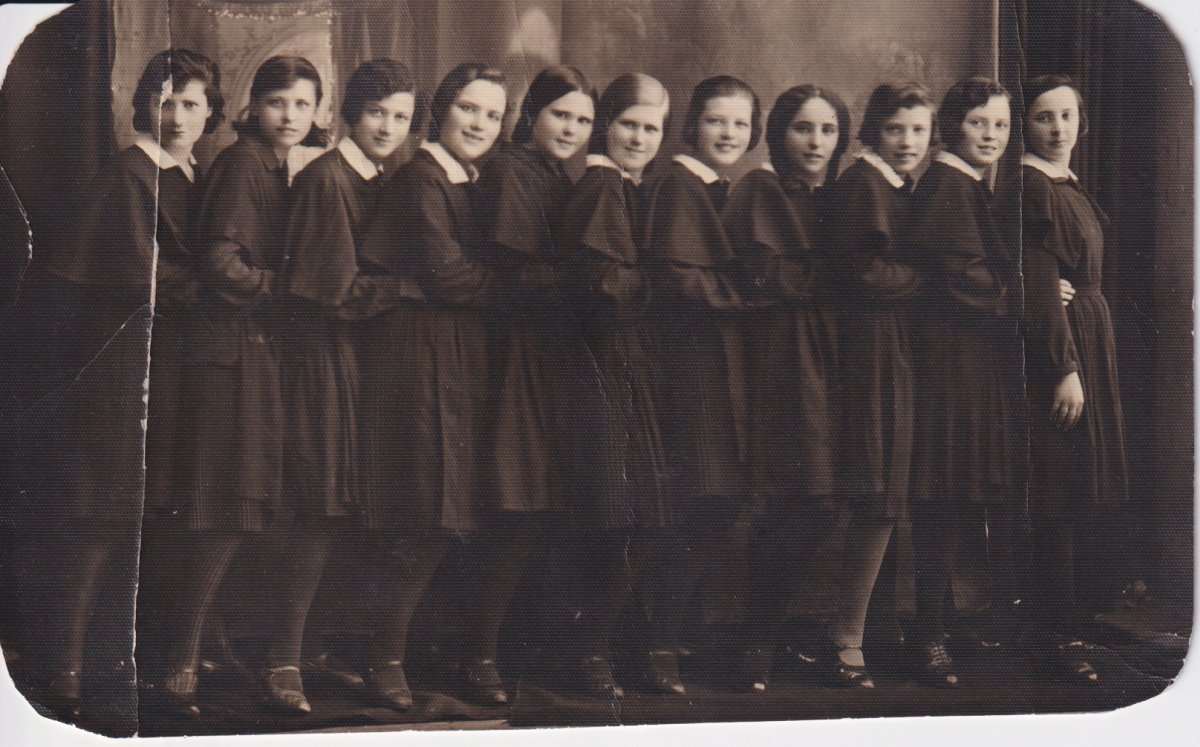
The Va grade students of Biržai gymnasium. The third from the left is Bunė Marozaitė. The first from the right is Frida Kivovičiūtė. 1931. From Jadvyga Pančkauskienė‘s archives.

The students of Biržai gymnasium together with the class teacher V. Klevickas. 1932. In the first row from the left: x, Kuprys. In the second row: x, Vanda Galvelytė, Marija Briedytė, Klevickas, Frida Kivovičiūtė (was shot in Alytus), Bunė Marozaitė, Michlė Leizerovičiūtė. In the third row.: Jonas Brazdžius, Klikavičius, Mirza Cukuraitė, Roza Timukaitė, J. Šernaitė, Jadvyga Šušytė, Romas Medelis, Pajauta Laučkaitė, Perelis Cobikas (from Nemunėlio Radviliškis). In the upper row: Krivickas, Kurtas Zigeris, x, Povilas Breivė (below), Jonas Šernas, x, Aleksandras Markevičius, Stasys Jakševičius, Špokevičius, x, Januševičius. Photo by B.Michelsonas. BRM „Sėla“ 21322/5.

Students of Biržai gymnasium. 2 May 1935. In the first row from the left the teachers sit: A. Karalius, A. Jurgutis, P. Andrėjauskas, V. Didžiulis, J. Vosylius, J. Kutra, M. Kačarauskaitė, J. Bružas, J. Švambarytė-Survilienė, , x. In the second row: Baltinis, Emilija Žemaitytė, Aleksandras Frankas, Emilija Užubalytė, Petras Zablockas, Klikavičius, teacher Ribbė, x. In the third row: Juozas Lazauskas, Marija Žemaitytė, Kurtas Zigeris, Irena Šernaitė, Chaimas Tabakinas (emigrated to the USA), Malvina Kvedaraitė, Zaronskis, Jadvyga Šušytė, Jonas Kiela, Elena Žagarytė, x. Photo by B. Michelsonas. BRM „Sėla“ 21322-7.

The Va grade students of Biržai gymnasium. 15 May 1935. In the first row from the left sits: M. Propisaitė, R. Rigmanaitė, Aneta Alimaitė, Elena Butėnaitė. In the second row: x, Povilonytė, Alė Timukaitė, Vlada Petkevičiūtė, Aldona Šamšonaitė, Veronika Vaičiulytė, Palmira Klybaitė, Zosė Jakubėnaitė. In the third row: Marytė Trainytė, Olga Sprindytė, E. Rabinaitė, teacher Zavišaitė, Plepytė, Elvira Kuginytė, Veronika Plutaitė, Antanina Olšauskaitė. In the fourth row: Valentina Markevičiūtė, Pranciška Matulytė, Stasė Jankauskaitė, x, Nina Klevickaitė, x. In the fifth row: Elena Šidlaitė, Adelė Vainauskaitė. Photo by B. Michelsonas. BRM „Sėla“ 21236.

The Jewish kindergarten on Rinkos street 1938. Only 3 children survived, the rest were killed in 1941 in Pakamponys. In the second row from the right to the left: the first is Tefka Kerbelis, the fourth is Gokaitė. BRM „Sėla“ PL1682.
The Jewish kindergarten on Rinkos street 1938. The educator is Hana Andrašiūnienė. Abraomas Kerbelis stands the fifth from the left. Benius Kerbelis sits the first from the left. BKM „Sėla“ PL1683.
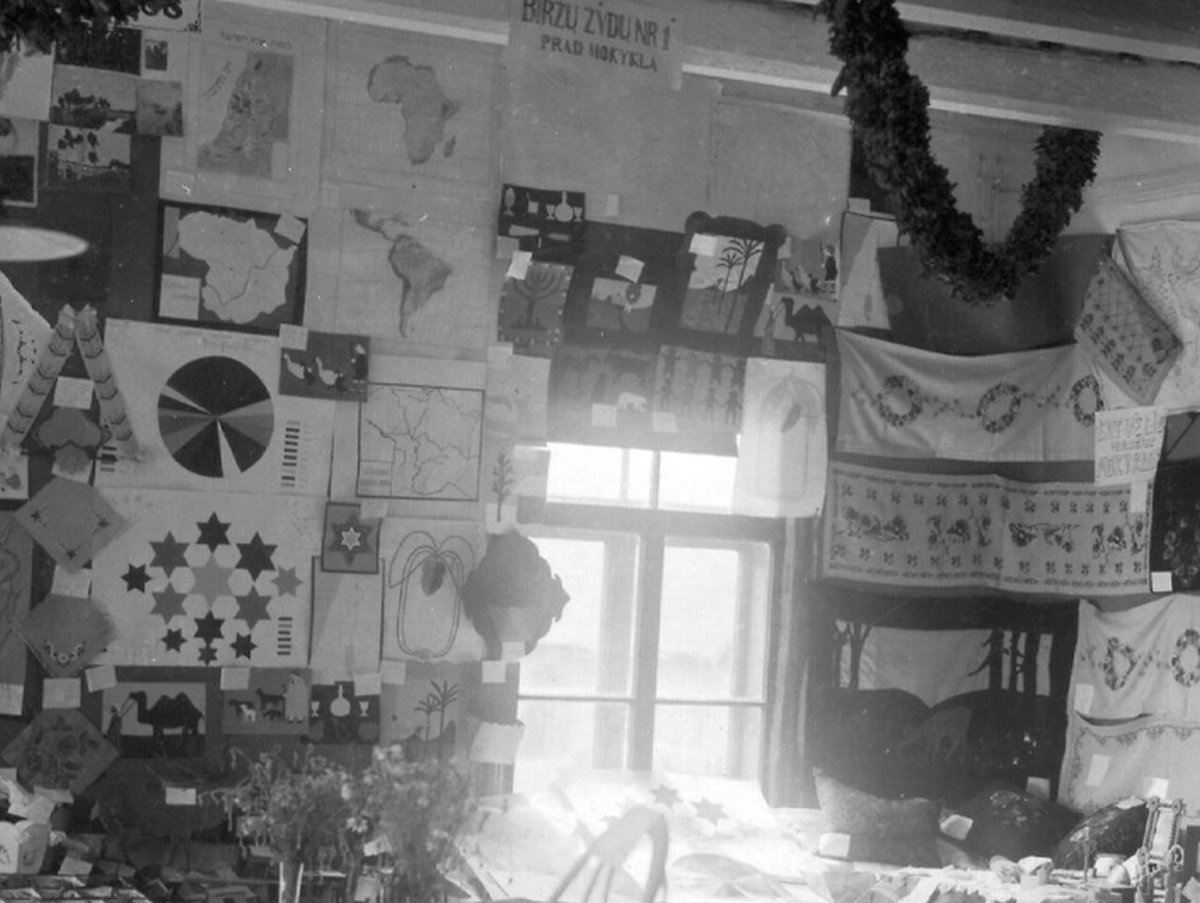
Exhibition of the handicrafts of primary schools students‘ from Biržai district (above the window - handicrafts from Biržai Jewish primary school No. 1). The ‘40s of the 20th century. Photo by P. Ločeris. BRM „Sėla“ 9329-6
Biržai Jews were very active town dwellers. They participated in the activities of municipality and numerous social organizations. In December 1919, a town council was elected consisting of 16 persons. On the list there were merchants Mordchelis Smilga, Riuvikas Chaitas, Mendelis Dorfanas, Leiba Tabakinas, and industrialist Leizeris Lurija. They made 43,75 % of the town council. Šolimas Kacas, Chackelis Gendleris, Hirša Zundelevičius, and Judelis Pasvaleckis also took part in town administration. Zalmanas Vaineris, Efrojus Bacheras, M. Etingas, Simsonas Lipšicas were the members of the town council in 1924. There were some names of the candidates to the town council in 1931, such as Abraomas Levinas, Solomonas Chodošas, Icikas Massas, Elijas Fridmanas, Geršonas Belickis.
Biržai branch of the Jewish Culture League had a library with about 300 books but with only 40 subscribers.
Zionist youth organizations active in Biržai included “HeKhalutz”, “HaShomer HaTsair”, “Beitar”, and “Gordonia” and had 60 to 70 members. The sports movements were “Maccabi” with about 50 members and a rather less active branch of “HaPo'el”.
Many Biržai Jews were members in the local voluntary fire brigade and were well represented in its management. Since the fire brigade owned three fire engines, it was the third in size after Kovno and Shavli. (Yosef Rosin)

The members of Biržai town council around 1930s. Sits from the left: Smilga, x, A. Marcinkevičius, V. Didžiulis, the chief of the district Vladas Rozmanas, burgermeister Povilas Klybas, J. Mikelėnas, Miežiūnas. Stands: Indriūnas, Chackelis Gendleris, Janulionis, x, x, Lipšicas, A. Vasiliauskas, x, Kairys. Photo by P. Ločeris. BRM „Sėla“ PL 4235-4.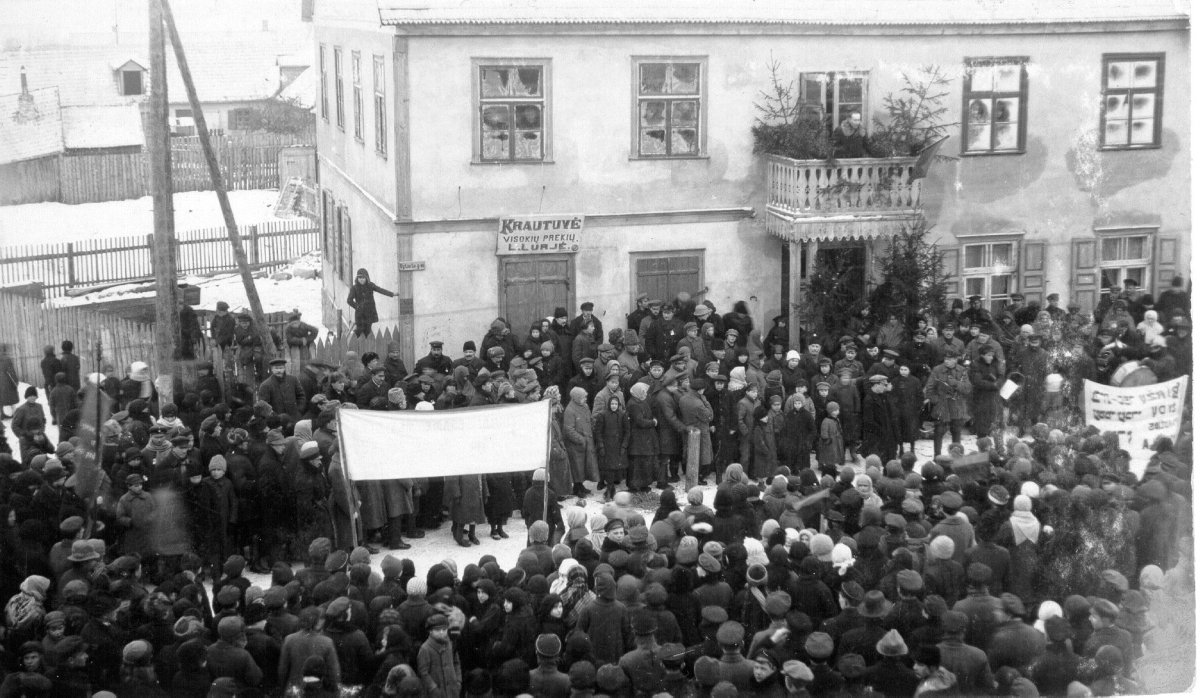
Biržai. The festival of the 16th February, the ‘30s of the 20th century. 15 Vytauto street was the house of the industrialist Leizeris Lurijo (Lurje). The rooms of the house were rented by Biržai gymnasium till 1931. Two banners are seen. One of them has words „We are born Lithuanians“, the other – „Biržai Jews primary school“. Photo by P.Ločeris. BKM „Sėla“ 20860-499.
The festive parade of Biržai volunteer firefighters association. Vytauto street (previously Dirvono), 1906. Photo by B. Michelsonas. BKM „Sėla“ 16107.
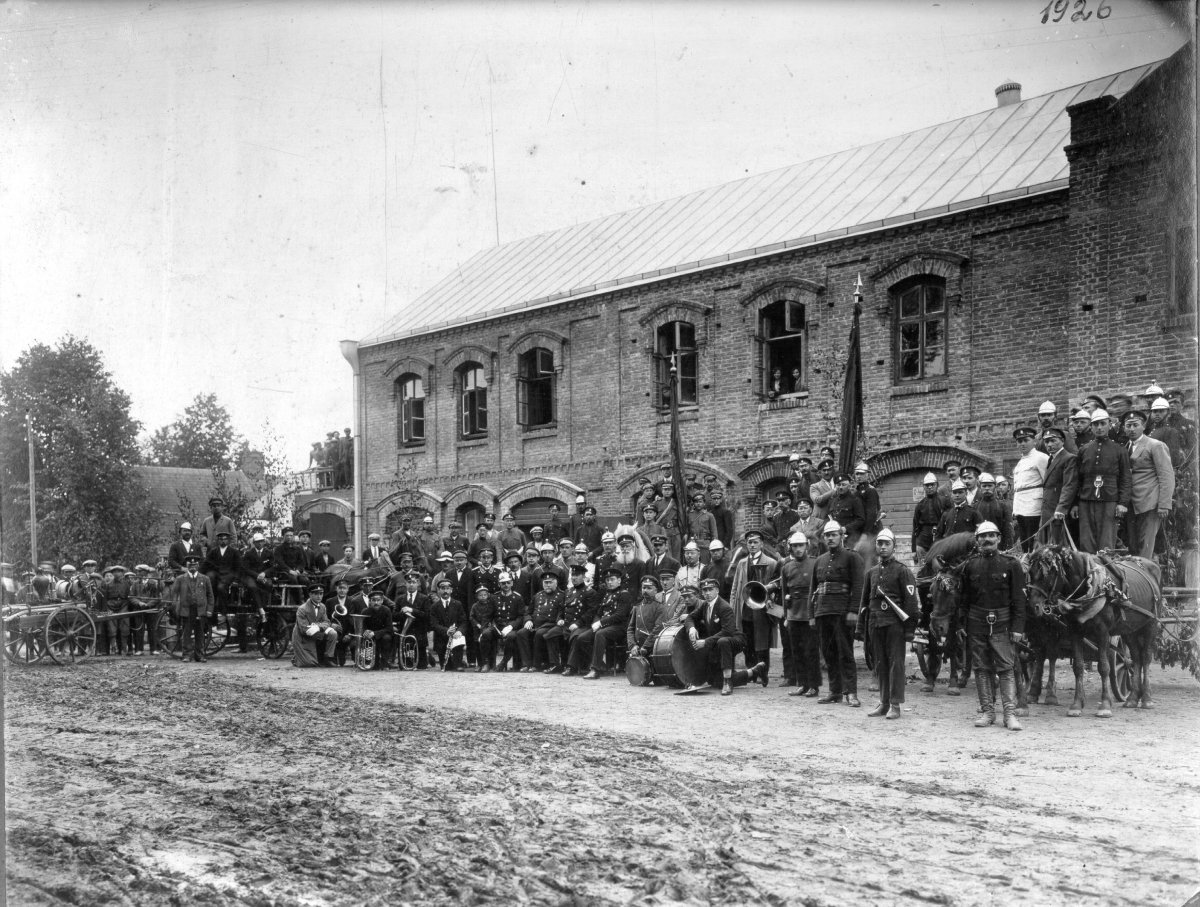
Biržai firefighters took a photo by the fire station on Vytauto street in the festive year of 1926. Biržai volunteer firefighters association was established in 1876. It was officially registered only in 1906. Photo by B. Michelsonas. BRM „Sėla“ 22202.

The administration of Biržai volunteer firefighters association. 1936. Sits from the left: photographer Boruchas Michelsonas (1871–1939), the chairman of the association and the chief of the team A. Puodžiūnas, Geršonas Belickis. Stands: Simonas Chaitas, S. Steponavičius, V. Budrevičius, J. Variakojis, Icikas Massas. Photo by B. Michelsonas. BRM „Sėla“ 21269/2.
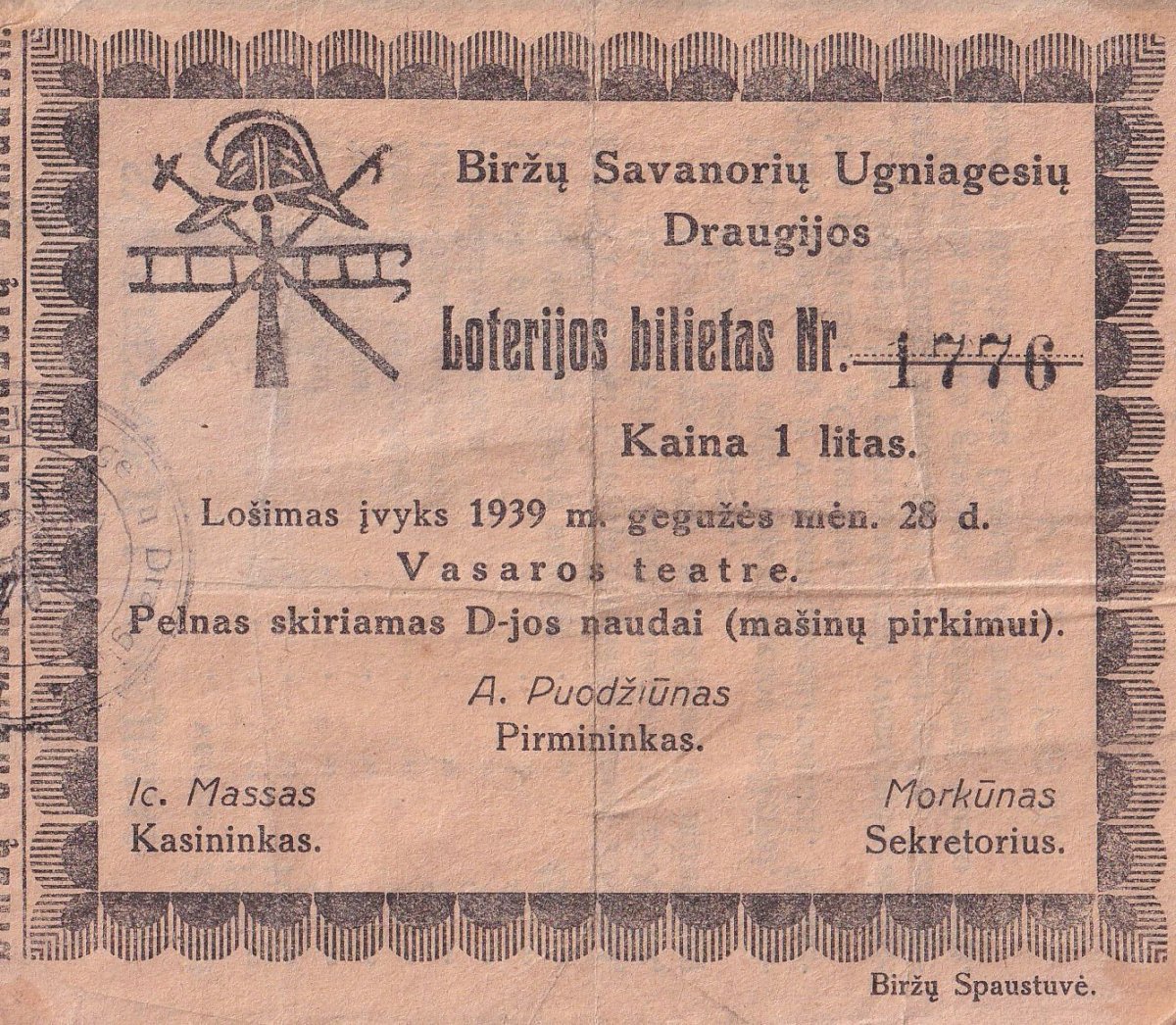
The ticket of the lottery organized by Biržai volunteer firefighters association.
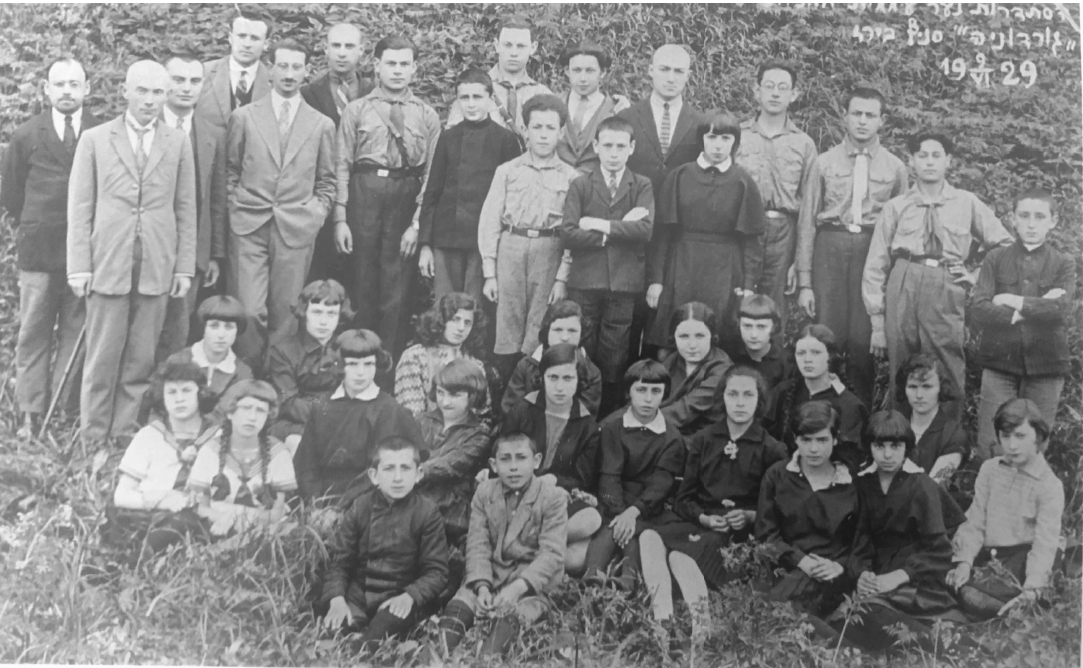
The youth of Biržai Jewish Scout Organization. 6 September, 1929. From the personal archives of Riva Friedman.
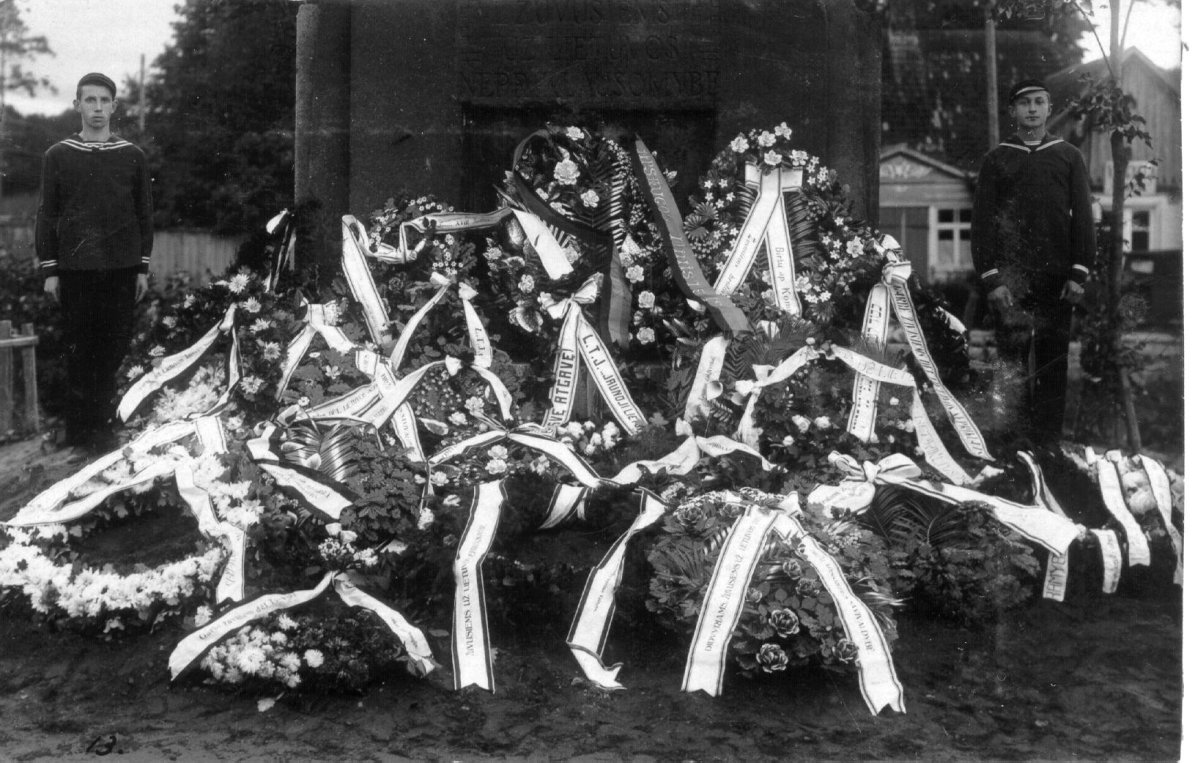
In 1931, on the initiative of Biržai the 18th riflemens’ unit, the monument was erected on Vytauto street to commemorate the dead for the Independence of Lithuania. On the right there is a wreath put by Biržai Jews scouts fellowships. Photo by P. Ločeris. BRM „Sėla“ 20860/423.


The ribbon from the wreath that was put by Biržai Jews scouts fellowships „BERIT-TRUMPELDOR“ and „HAŠOMER HACOIR“ by the memorial to comemmorate the dead for the Independence of Lithuania, 1931. BRM „Sėla“ 18171/34.
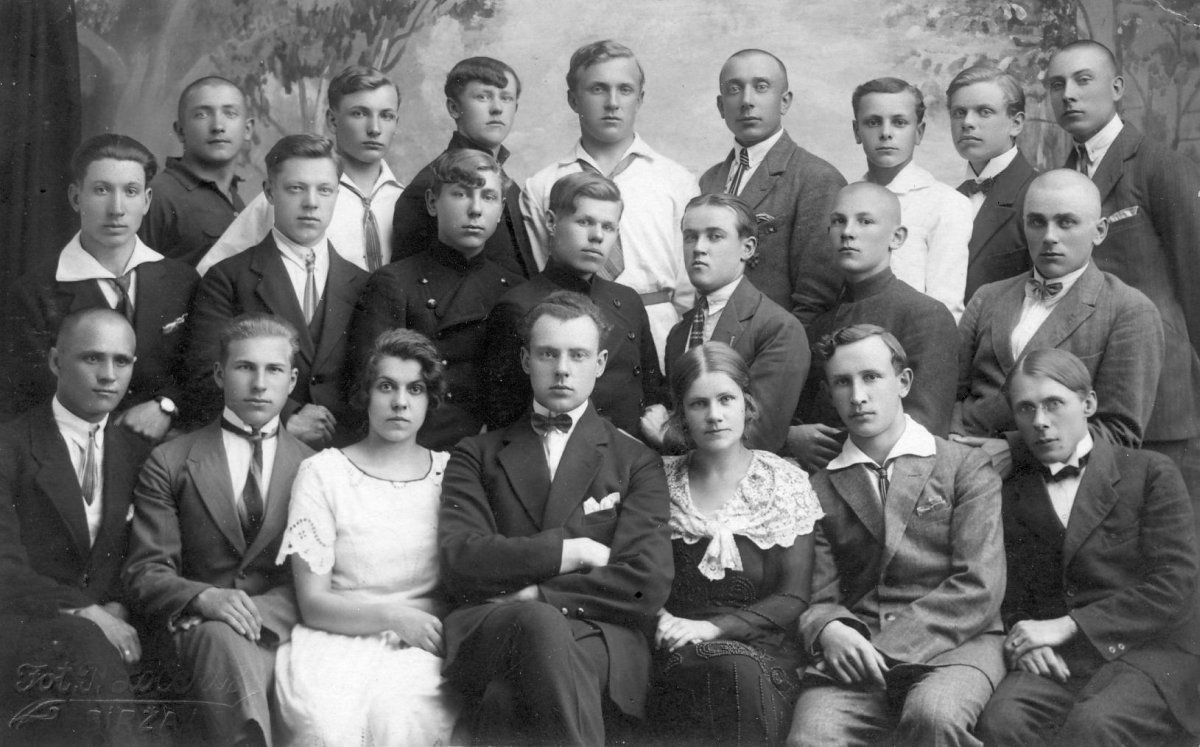
The constituent assembly of Lithuanian Physical Education Union Biržai club. 1925. Sits from the left: Jukna, V. Kvedaras, Mosakaitė, the chairman of the council J. Šlekys, Šlekienė, secretary J.Niurka, x. In the second row: Raugalas, Gilys, Aukštikalnis, Vorobjovas, J. Žilvytis, V. Niurka, Prienas. In the third row: Tališauskas, Riselis, A. Paškevičius, Vidutis, Lubavičius, Mosakas, Pikelis, Sakalauskas. Photo by P. Ločeris. BRM „Sėla“ PL4867.
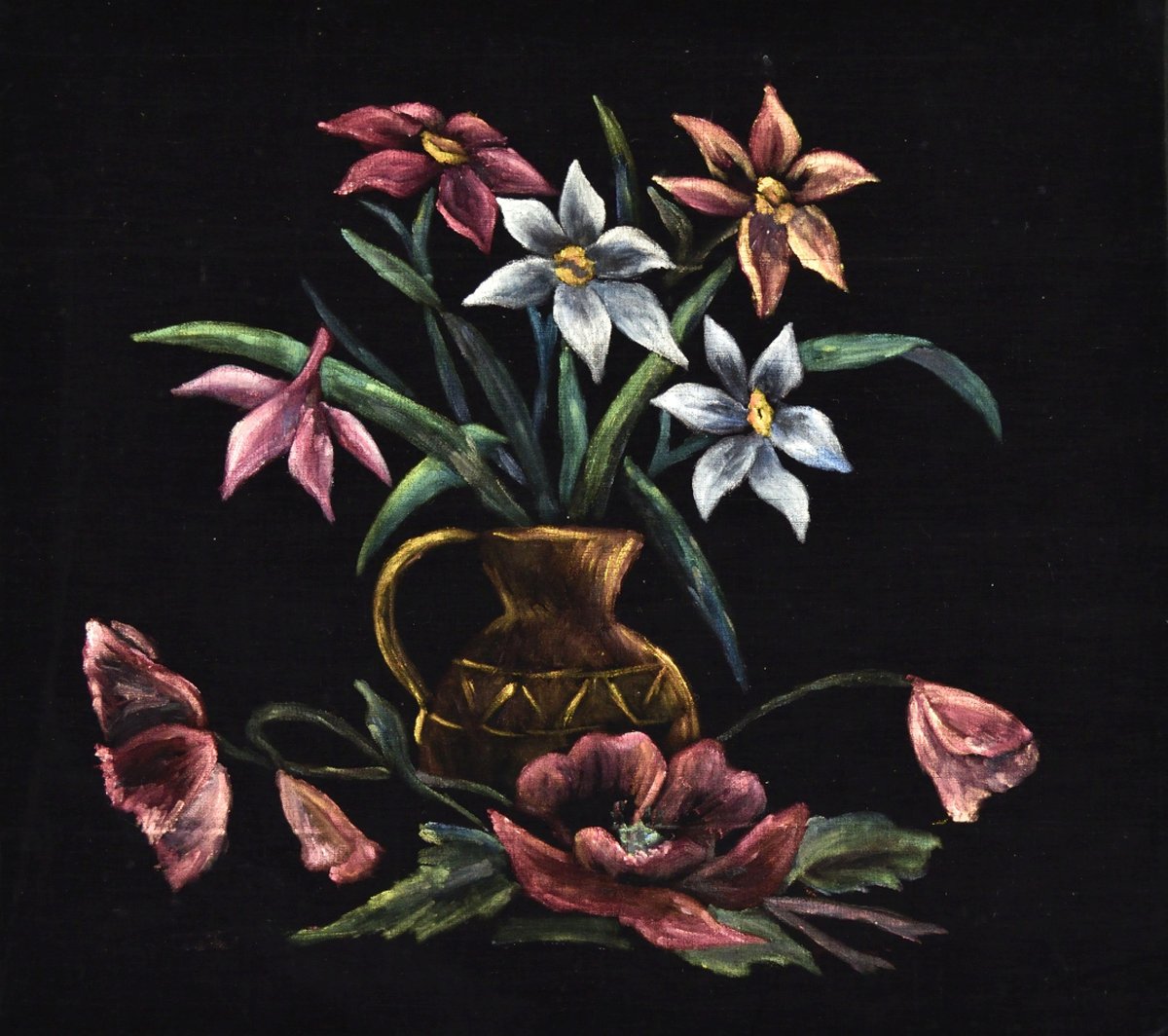
Painted flowers from Jewish girl Etingaitė. The 40’s of the 20th century. BRM „Sėla“ 10843

Biržai. The crossroad of Vytauto and Kęstučio streets. The ‘30s of the 20th century. The building at 15 Vytauto street (later 20). The signs: „Warehouse / of alcoholic drinks /only for take-out / L. Lurjė.", Shop / of various goods / L.Lurjė.“ The Jewish students with a flag. The flag of the Jewish organization, the word „council“ is clearly seen. Photo by P. Ločeris, BRM „Sėla“ 20860/501.

Biržai. Vytauto street. The ‘30s of the 20th century. No. 28a was Basė Nankinienė‘s hotel „Komercia“, No. 26a – Giršas Zundelevičius‘s hotel „Metropol“. Photo by P. Ločeris. BRM „Sėla“ 21974.
Biržai. Vytauto street. 1939. On the left: at 26a Vytauto street was Giršas Zundelevičius‘s insurance agency „Lietuva“, the hotel „Metropol“, the gas station SHELL. Photo by J. Skrinskas. BRM „Sėla“ 13893.

Biržai. Vytauto street. 1939. On the left there are the houses of: 1 – Hitel Nankinas, 2 – Peisachas Melamedas, 3 – Giršas Zundelevičius, 4 – Kontaras Jona, 5 - No. 22 Aronas Ezrachovičius, 6 - No. 20 – Zundelis Gendleris. BRM „Sėla“ 17541.

Biržai. The crossroad of Vytauto and Karaimų streets. The ‘40s of the 20th century. On the right: at 13 Vytauto street there was a bulk warehouse of kerosene and sugar. It belonged to Icikas Massas and functioned from 1928 to 1940. Photo by P. Ločeris. BRM „Sėla“ 9401..jpg)
The wall clock made in Germany and bought at E. Davidovas‘s watches and glasses shop, at 10 Vytauto street. BRM „Sėla“ 29240..jpg)
The stamp of E. Davidovas‘s watches and glasses shop. 1929. At 10 Vytauto street. BRM „Sėla“.
Biržai marketplace on Rinkos square. Not far away were the streets of Rinkos and Krautuvių eilės where Jews houses and shops stood. The ‘30s–‘40s of the 20th century. BRM „Sėla“ 9331.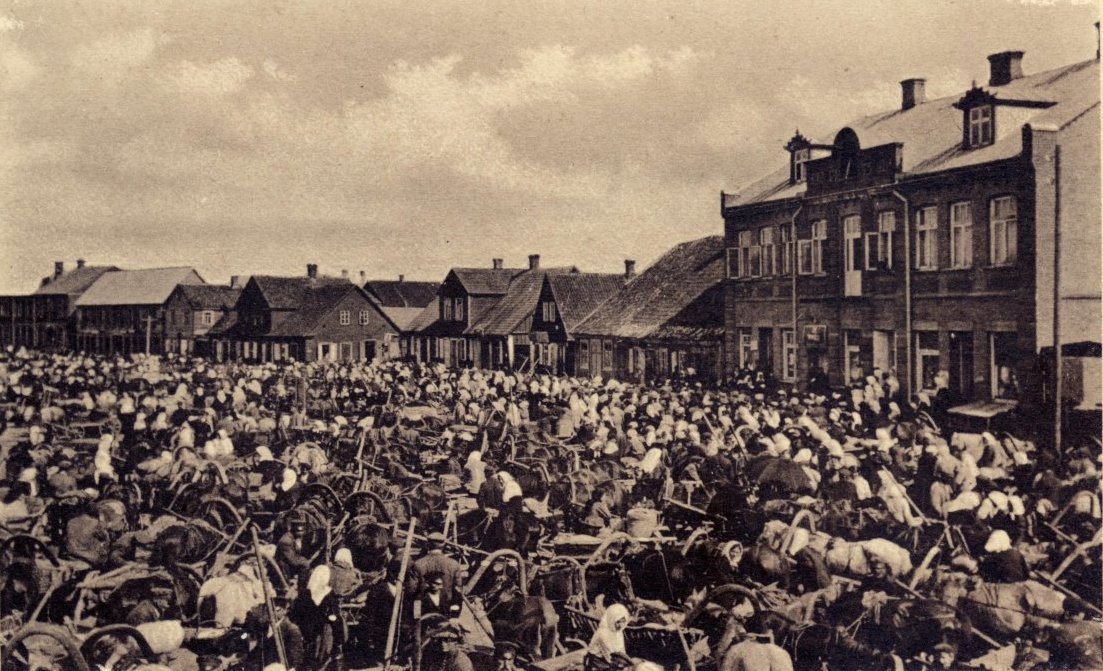
Biržai marketplace on Rinkos square. On the right there is a brick building from 1912 - Biržai police station. There were workshops and shops in the building. Now it is rebuilt, at 7 J. Janonio square.
Biržai marketplace on Rinkos square. On the right there was a police station in the brick building constructed in 1912. There were workshops and shops in the building. The inscription on one sign is „Manufactory shop. S. Levin“. Photo by P. Ločeris. BRM „Sėla“ 17550.
Rinkos square. On the left there is a building where was Biržai branch of Small credit bank of the Farmers‘ association and the cooperative „ Ūkininkas “ (3 Rinkos square). Photo by P. Ločeris, BRM „Sėla“ 20860/313.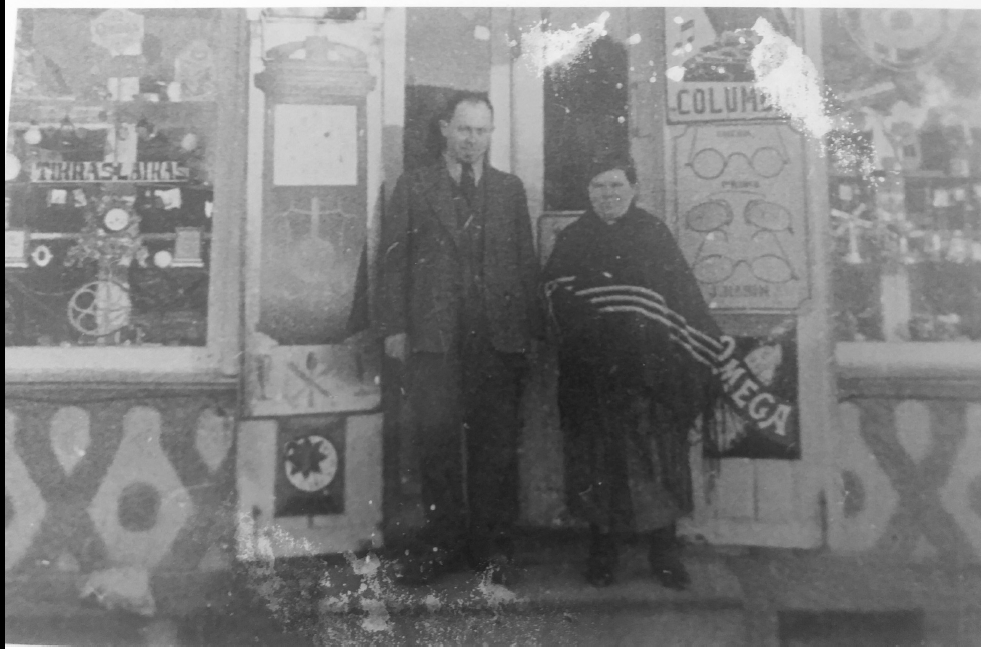
Joselis Rabinas (1882–killed in Pakamponys on 8 August 1941) with his wife Ševa (1885–killed in Pakamponys on 8 August 1941) at their shop where they used to sell watches, clocks, bicycles and radio sets. The shop was at 5 Rinkos square. From the personal archives of Riva Friedman.
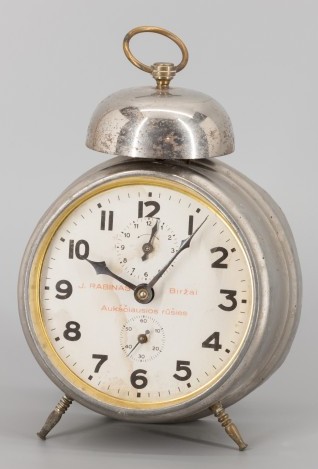
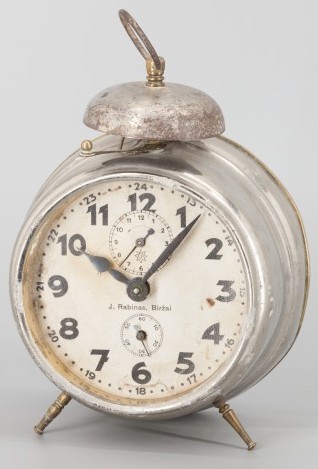
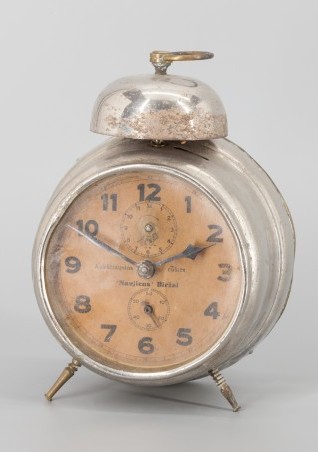 The alarm clocks made by Joselis Rabinas. He also owned a shop at 5 Rinkos square that sold clocks, bikes and radio sets. The ‘40s of the 20th century. BRM „Sėla“ 19877/1, 19877/2, 19877/3.
The alarm clocks made by Joselis Rabinas. He also owned a shop at 5 Rinkos square that sold clocks, bikes and radio sets. The ‘40s of the 20th century. BRM „Sėla“ 19877/1, 19877/2, 19877/3.
.jpg)
.jpg)
The building of Biržai Jews Bank on Dagilio square (the building hasn‘t survived). The ‘30s of the 20th century. BRM „Sėla“ 20860/484, 20860/347..jpg)
a.jpg)
The postcard with a message from Biržai Jews Bank. BRM „Sėla“ 22384..jpg)
.jpg)
The receipts of Biržai Jews Bank, 1937. BRM „Sėla“ 30547/1, 30547/1.
The stamp of Lithuanian united craftsmen association Biržai branch in Lithuanian and Yiddish. BRM „Sėla“ 3146.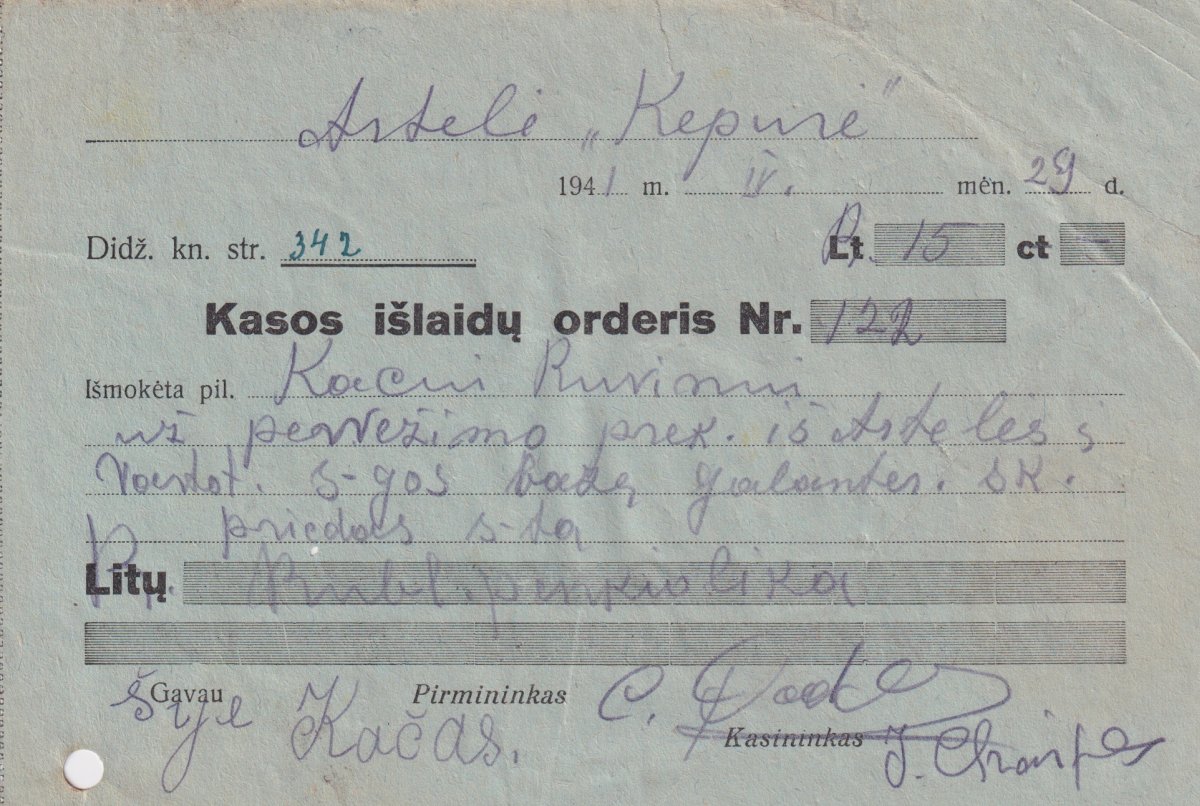
The warrrant of cash expenses of the artel „Kepurė“. It certifies that Kacas Ruvinas was paid 15 rubles for the transportations service. The cashier was I. Chaitas. 29 April, 1941. BRM „Sėla“ 14109/9.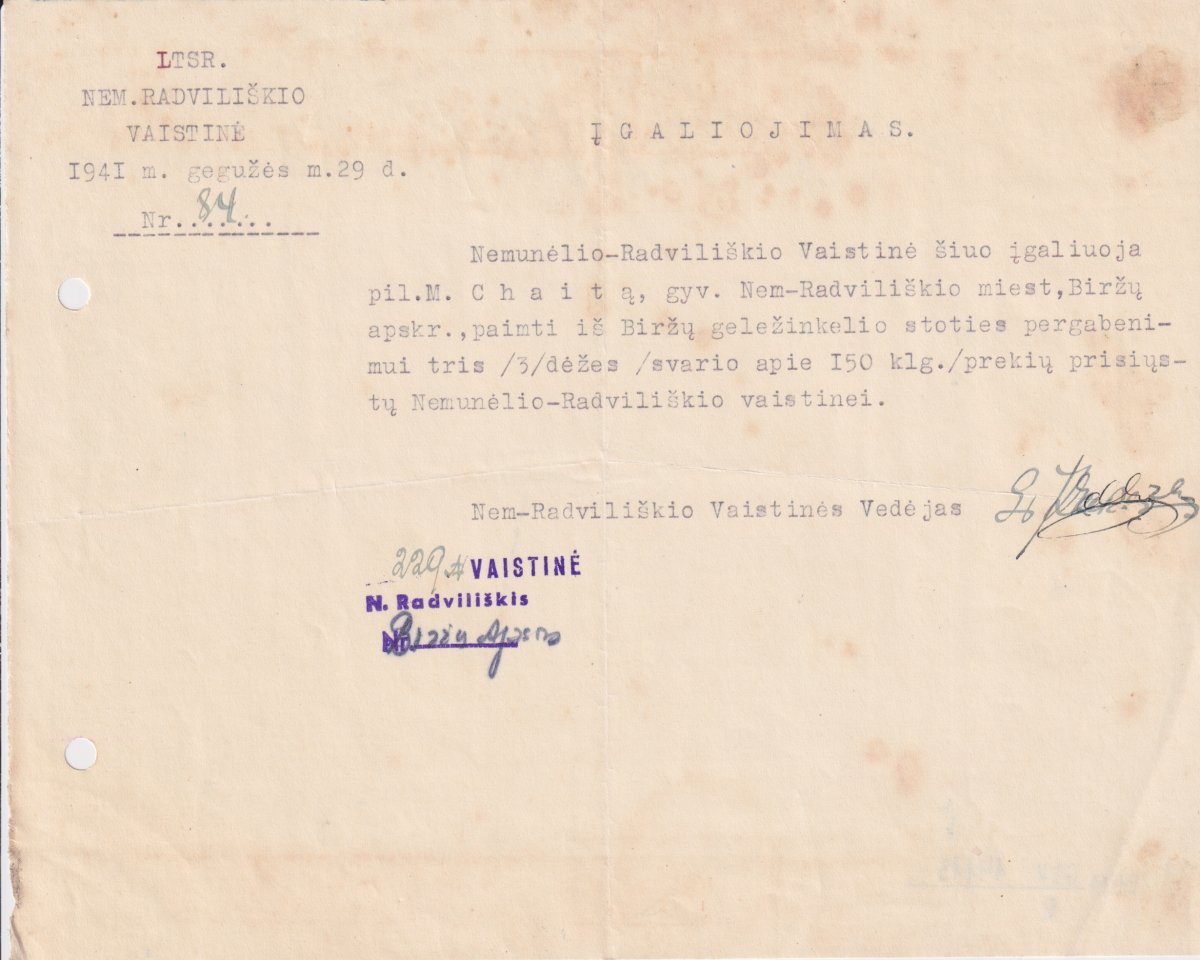
The mandate to M. Chaitas to take the goods from Biržai railway station to bring them to the pharmacy of Nemunėlio Radviliškis. 29 May, 1941. BKM „Sėla“ 14113
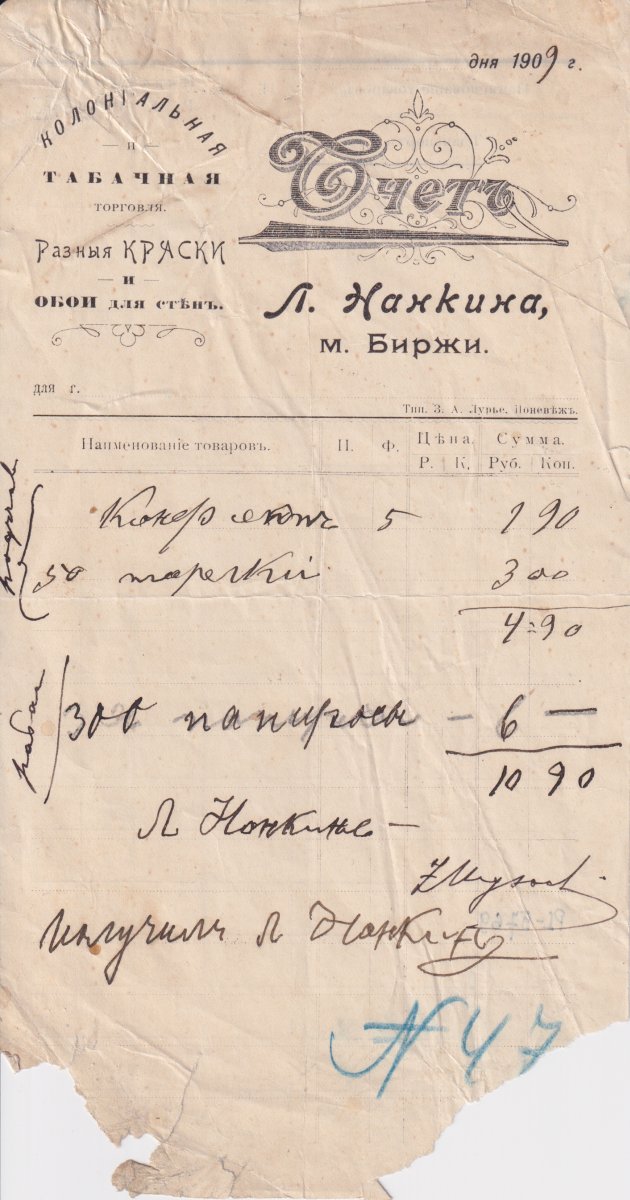
The receipt from L. Nankinas‘s colonial goods shop. 1909. In Russian. BRM „Sėla“ PL5769

The youth from Nemunėlio Radviliškis (Biržai district) together with the Jews who were shot in 1941. The photo was taken on 15 August, 1933. From the left: Žagarytė, Šaulytė-Gelažnikienė, Kvedaraitė, Jakševičius, Aronas Perelis (in 1941, he, his wife, her parents and a baby daughter were killed in Alytus), Michelė Leizerovičiūtė (was shot in Nemunėlio Radviliškis), Roza Timukaitė, Bunia Morozaitė (was killed in Biržai), Frida Kivovičiūtė (Aronas Perelis‘s wife), Stela Lipšicaitė. BRM „Sėla“ 13799/2.

The Leizerovičiai lived in Nemunėlio Radviliškis till 1941. The parents (sit) and a daughter (stands with her husband in the center) were shot in Nemunėlio Radviliškis in 1941. The Leizerovičiai‘s sons (stand on the left and on the right) participated in the World War II as the soldiers of the 16th Lithuanian division and died in war. BRM „Sėla“ 13799/1.

The Kerbeliai in 1936. Stands from the left: Moisiejus Kerbelis‘s grandfather Achbaras Šija (was killed in 1941), Dvaira Bezemacheraitė-Kerbelienė (1911–1993, Moisiejus‘s wife); Hana Achberait-Kerbelienė (Mosiejus‘s mother who was killed in 1941), Moisejus Kerbelis (1906–1995) with children: Tevja (1935–2003), Chaimas-Benušas (1933–2004)and Abramas-Laizeris (1932–1980). BRM „Sėla“ PL1681.

Dentists B. S. Orlovskiai. S.Orlovskis emigrated to Israel before the World War II while his son moved to Russia. B. Orlovskienė and her daughter were shot in Pakamponys. Photo by B. Michelsonas. BRM „Sėla“ 12617.

Izraelis Šapiro‘s (Sapiro) grandparents Aronas and Sara Šapiro. The ‘40s of the 20th century. Unknown photographer. From the personal archiveS of Frima and Izraelis Sapiro.

Izraelis Šapiro‘s (Sapiro) father – Šimcha Zelikas Šapiro, was born in 1911 in Biržai. In 1928 he emigrated to Brasil. From the personal archives of Frima and Izraelis Sapiro.

Šimcha Zelikas Šapiro‘s sister Golda Lėja. The brother emigrated to Brasil in 1928, and she stayed in Biržai. Her destiny is unknown. 1936. Photo by B. Michelsonas. From the personal archives of Frima and Izraelis Sapiro.

The Gordonai. From the left: Zunderis Gordonas, Cipa Gordonaite, Šalom Gordonas, Brainė Gordonaitė-Šapiro, X, Jakobas Gordonas. 1926. Unknown photographer. From the personal archives of Frima and Izraelis Sapiro.

Izraelis Šapiro‘s (Sapiro) mother Braine Gordonaitė (on the left) and her sister Cipa (maybe Rachelė?). Braine Šapiro (born in 1910) emigrated to Brasil from Biržai in 1929. There she married to Šimchas Zelikas Šapiro. Her father Jude Gordonas was a roofer and a tinsmith. Photo by V. Bortkevičiūtė, Biržai. From the personal archives of Frima and Izraelis Sapiro.

Zunderis Gordonas with a boy. The ‘40s of the 20th century. Unknown photographer. From the personal archives of Frima and Izraelis Sapiro.

Jakobas Gordonas. Photo by B. Michelsonas. From the personal archives of Frima and Izraelis Sapiro.

Sisters Sonia Geselevičiūtė (on the left) and Hana Geselevičiūtė-Evenienė. Biržai. 1928. Sonia was killed in 1941, and Hana left to the USA. From Elena Gordon's personal archives.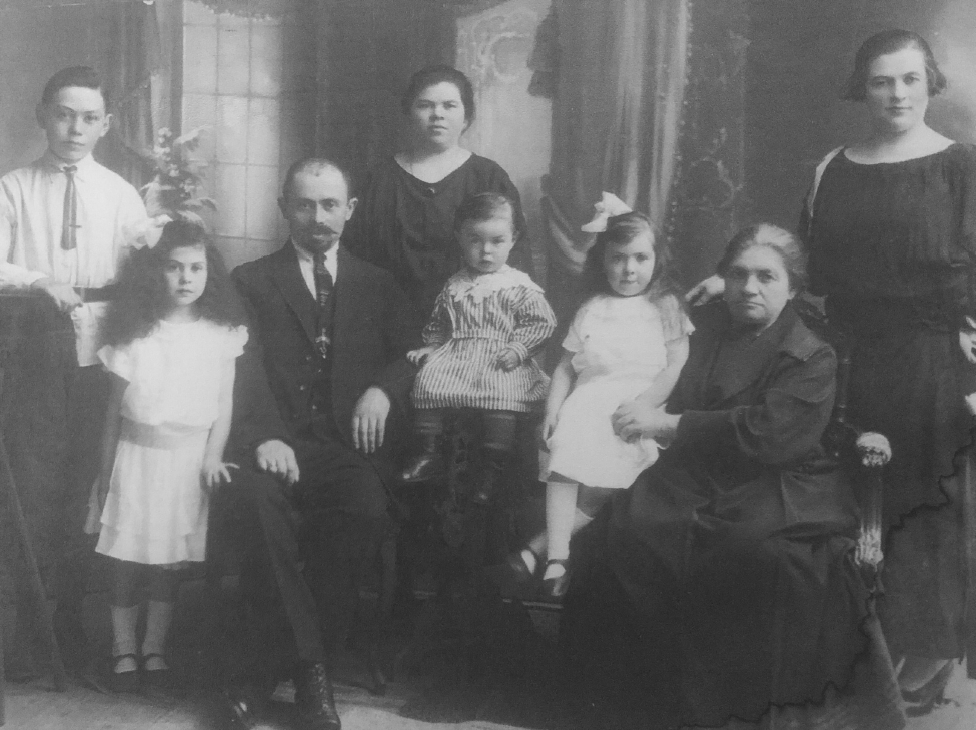
Joselio Rabino šeima, XX a. 3-deš. Biržai. Iš kairės Zalman Tzvi Rabin (g.1910 – m.1973), Esther Rabin (g.1914 – nužudyta Pakamponyse 1941-08-08), Joselis Rabinas ( g.1882 m. – nužudytas Pakamponyse 1941-08-08), Ševa Rabin (g.1885 – nužudyta Pakamponyse 1941-08-08), Mošė Rabin (g.1918– nužudytas Pakamponyse 1941-08-08), Gita Rabin (g.1916– nužudyta Pakamponyse 1941-08-08), x, x. Asmeninis Rivos Friedman archyvas.
The youth of Vabalninkas Jews, 1939. Photo by J. Daubaras. BRM „Sėla“ PL1773.
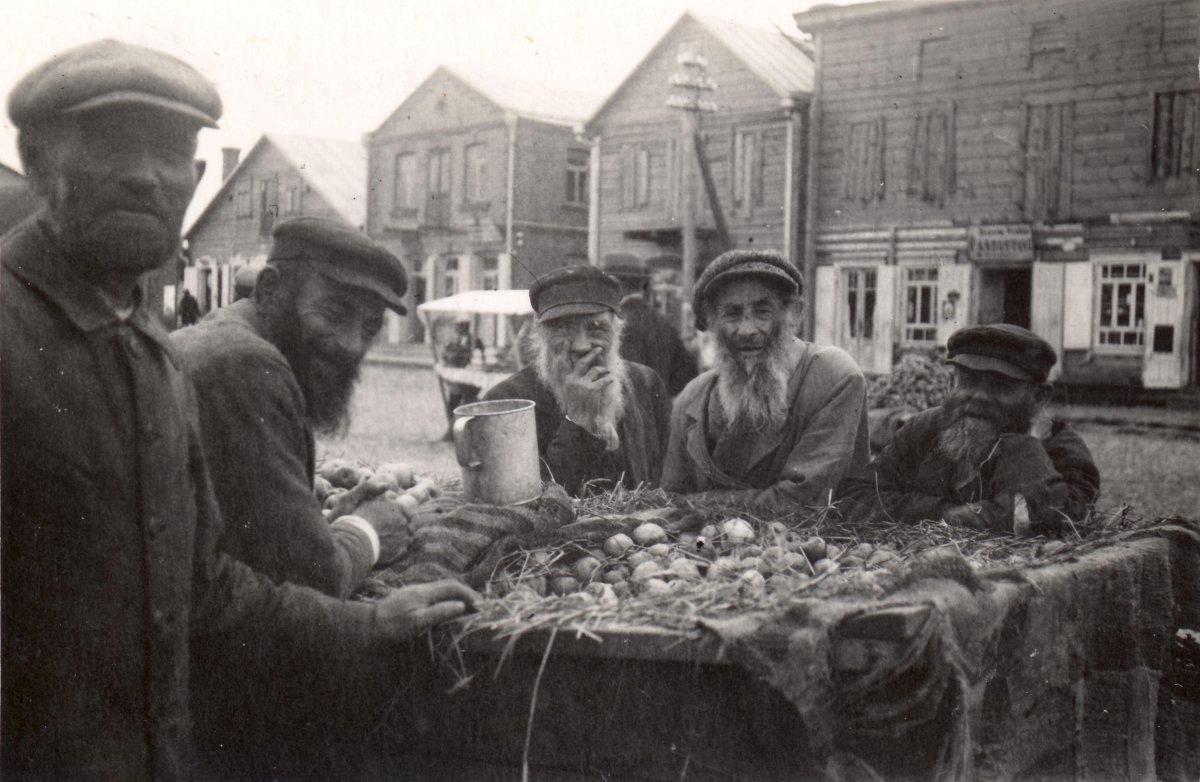
Vabalninkas Jews, apple sellers (so-called kupčiai (i.e. merchants)). 1931. BRM „Sėla“ 20637/6.

Elija Fridmanas, Leibas‘s son, born in 1882, lived at 14 Vytauto street in Biržai and was the owner of a bulk shop (from 1927 till nationalization in August, 1940). On 14 June 1941, he was arrested and sentenced for 8 years in a special camp. In 1947 he returned to Lithuania but in 1948 he left to his family in Tomsk. In 1956 he was released from exile. On 13 June 1941, his wife Pesė Fridmanienė, Zalmanas‘s daughter, born in 1902, as a wife of a big industrialist, and their sons Leiba, born in 1927, Zalmanas Icikas, born in 1932, and Šolomas Morduchas, born in 1929, were deported to Tomsk oblast. They were released from exile in 1956. Lithuanian Special Archives.

Moisej (Mauša) Gendleris, Šlioma‘s son, born in 1886, lived at 14 Vytauto street in Biržai. He was an industrialist and a trader who had a wooden house (14 Vytauto street), a sawmill (1 Stoties street), a lemonade factory (14 Vytauto street), a town bathhouse (21 Apaščios street). On 15 June 1941, he was arrested and sentenced for 5 years in a special camp. In 1946, he left to his family in exile, in Tomsk oblast. He died in Tomsk in 1956. On 19 June 1941, his wife Norim (Lėja) Gendlerienė, Notelis‘s daughter (1885–1962), a dentist, their sons Natanas Gendleris, born in 1918, and Elchonas Gendleris, born in 1923, were deported to Tomsk oblast. Lithuanian Special Archives.

Norim (Lėja) Gendlerienė, Notelis‘s daughter (1885–1962), a dentist. On 19 June 1941, she was deported to Tomsk oblast. In 1958 she was released from exile without the right to live in Lithuania. Lithuanian Special Archives.

On 19 June 1941, Elchonas Gendleris, born in 1923, was deported to Tomsk oblast. In 1958 he was released from exile without the right to live in Lithuania. He studied at Tomsk medical institute. Lithuanian Special Archives.

Roza Lipšic, Geršonas‘s (Hiršas) daughter, born in 1890, lived at 37 Vytauto street in Biržai. On 18 June 1941, Roza and her husband Chackelis-Lazaris Lipšicas, Naumas‘s son, (born in 1885), and their children: Dora-Cerena, born in 1927, Mera, born in 1941, Nochamas (Naumas), born in 1929, and Davidas Lipšicas, born in 1934, were deported to Kranoyarsk krai as they were big traders. She was released in 1958. The photo was taken in 1952. Lithuanian Special Archives.

Davidas Lipšic, Chackelis-Lazaris‘s son, born in 1934. He was released from exile in 1954. The photo was taken in 1952. Lithuanian Special Archives.

Dora-Cerena Lipšic, Chackelis-Lazaris‘s daughter, born in 1932. She was released from exile in 1954. The photo was taken in 1951. Lithuanian Special Archives.

Motelis Levitan (1894–1973) and Dora Levitan (died in 1971), around the ‘70s of the 20th century. The Valintėliai from Dvaroniškis farmstead hid Motelis Levitan in 1941–1943. Dora Levitan was hidden by the Jievaltai from Mediniškiai village. After the war Motelis Levitan married Dora. They raised Dora‘s son Abelis (he was rescued by the Balčiūnai from Jaunučiai village), later they had a daughter Golda. From Elvyra Valintėlytė-Čižauskienė personal archives.

Brother and sister, Abelis (Bolis) and Golda Levitan. From Elvyra Valintėlytė-Čižauskienė personal archives.

In 1941, Šalom (Simas) Melamedas (born in 1922) was mobilized for the 16th Lithuanian division of the Red Army. After the World War II he returned to Biržai and worked in trade. From Leta Vainorienė personal archives.

Šeftelis Melamedas (1926–2015). In 1941, Šeftelis Melamedas and his brother who was to be a soldier moved to the Soviet Union and avoided the Holocaust. The rest of Tthe family - mother Pajė, father Peisachas and brother Hirša - were killed in Pakamponys. In 1945, Šeftelis returned to Biržai and worked in Biržai bakery and a construction organization of Biržai district. From Leta Vainorienė personal archives.

Moisejus Kerbelis (1906–1995). When the army of the Nazi Germany occupied Lithuania, he and the family moved further into the Soviet Union. In the town of Kirov he joined the 16th Lithuanian division of the Red Army. He returned to Biržai after the World War II, was in charge of Biržai printing house. Later he worked in the committee of the Lithuanian communist party Biržai department. BRM „Sėla“.

Michailas Tabakinas (1925–1974). He participated in the World War II, and then returned to Biržai. From 1954 he was in charge of Biržai canteen and a restaurant. BRM „Sėla“.
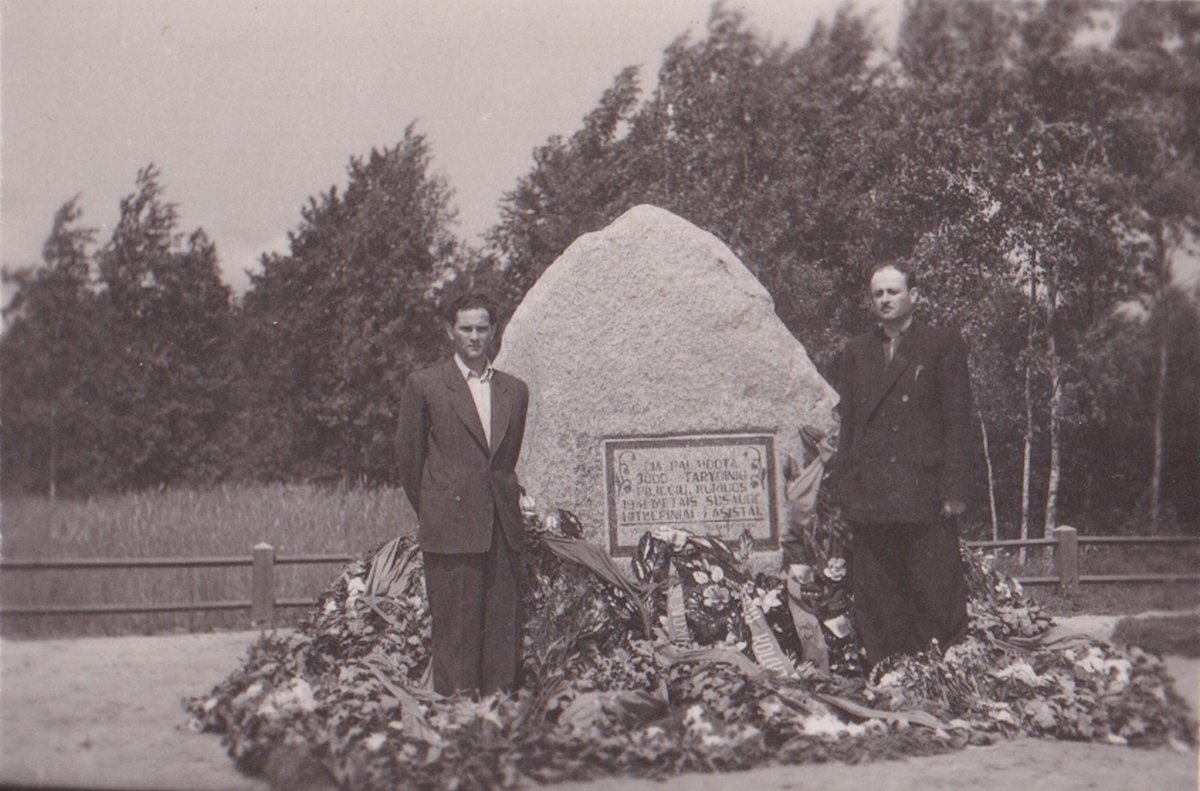
Šeftelis Melamedas (on the left) and Michailas Tabakinas (on the right) by the memorial in Pakamponys forest that was built in 1955 to commemorate the victims of the Holocaust. BRM „Sėla“.
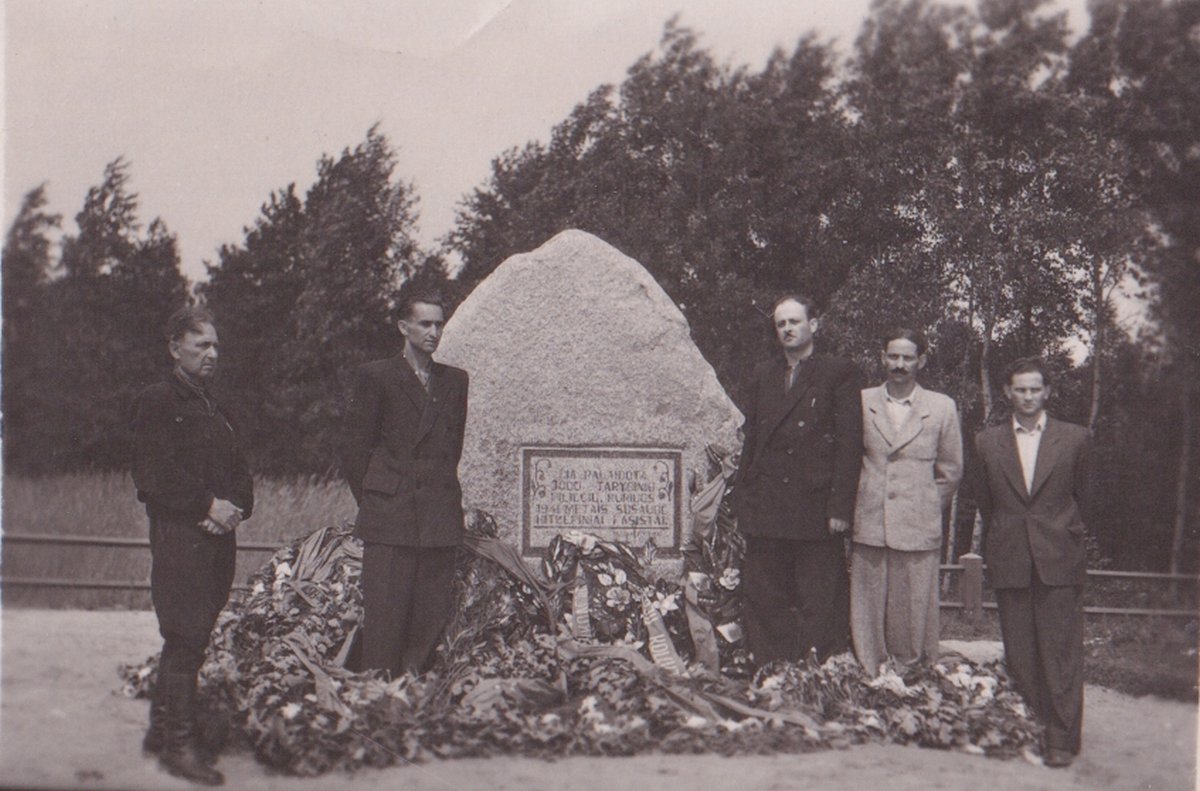
From the right: Šeftelis Melamedas, Abram Matisonas, Michailas Tabakinas, Abraomas Kerbelis, Moisėjus Kerbelis by the memorial in Pakamponys forest that was built in 1955 to commemorate the victims of the Holocaust. BRM „Sėla“.

Address: Radvilos 3, LT-41175, Biržai
Company code: 190562082
Telephone: +370 450 31883
E-mail: sela@birzumuziejus.lt
Data is collected and stored at the Registry of Legal Entities
